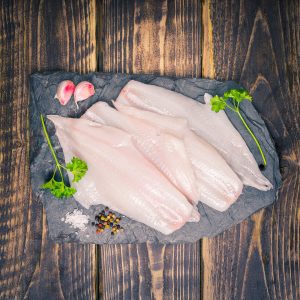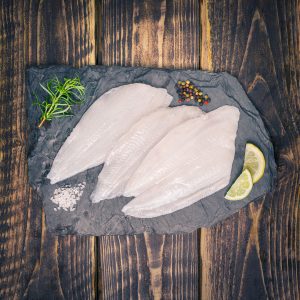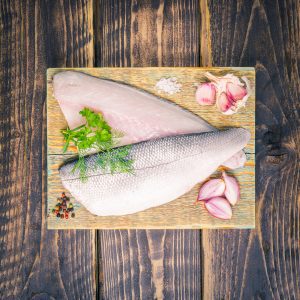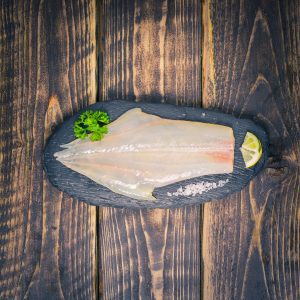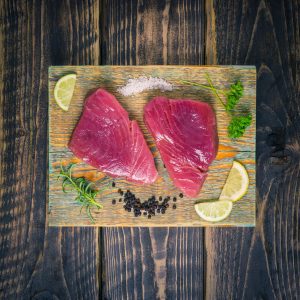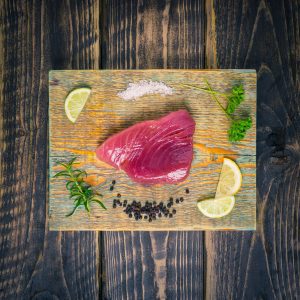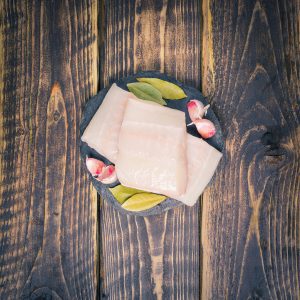The largest flatfish in the world, halibut was much maligned for many years until chefs took a liking for the creamy, firm and meaty flesh, and it has taken top billing on menus ever since. Now on the endangered list, buy our sustainably farmed halibut for cooking at home and pair the gentle flavour of this titan of the deep with bolder seasoning for a meal to remember.
WHAT IS HALIBUT?
The giant of the Pleuronectidae flatfish family, halibut or Hippoglossus hippoglossus lives in the wild in cold, deep Atlantic waters, as well as around Iceland, Greenland and Scandinavian waters, besides the northern reaches of the North Sea.
Halibut can grow up to 2.5m long and weigh as much as 350kg. A demersal fish, it sits comfortably at the very top of the food chain and feeds by hunting other fish near the seabed, from cod and whiting to haddock and other flatfish.
Preferring waters at least 50m deep, halibut dive to depths of more than 1000 metres to spawn in the winter months. Females can release from a few thousand to several million eggs, depending on the size of the fish, which take about 15 days to hatch.
With wild stocks heavily overfished and halibut these days listed as an endangered species, it’s essential that you buy from a reputable farm. Our supplier is Gigha Halibut, on the island just off the west coast of the Kintyre peninsula. Established in 2006, the business was harvesting premium fish a year later and went on to win awards for its products and practices, including best food producer in the 2014 BBC Food and Farming Awards and agriculture and aquaculture winner at the Scottish Rural Awards in 2015.
CLICK HERE TO BUY HALIBUT FILLETS
CLICK HERE TO BUY HALIBUT STEAK
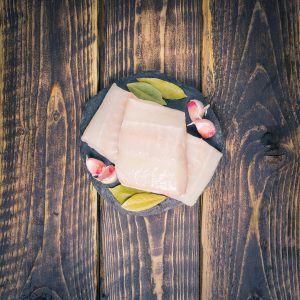
With a slim diamond shape and a dark brown, green or black back, the halibut usually has a mottled light and dark pattern with a pale underside. The eyes are on the right-hand side and the tail is slightly forked. The mighty fish has a prominent curve in the lateral line and a large mouth with sharp teeth for scooping up smaller fish. The fins are long and run the full length of the body.
Halibut has a mild and sweet taste with very lean, white flesh that is similar to turbot.
A marvel of nature, it’s no surprise the doughty halibut moved William Cowper to praise it in verse in 1784 in To the Immortal Memory of the Halibut on which I Dined This Day:
Indebted to no magnet and no chart,
Nor under guidance of the polar fire,
Thou wast a warrior on many coasts,
Grazing at large in meadows submarine.
WHAT’S AVAILABLE?
Common cuts of halibut are fillets and steaks.
Halibut fillets are cut on the dark side of the fish, along the lateral line, sliced from the head to the bone, from neck to tail. Halibut steaks are cut from the body of the fish, perpendicular to the backbone.
IS HALIBUT GOOD FOR YOU?
Packed with micronutrients, halibut is an excellent source of selenium, a powerful antioxidant that helps the body repair damaged cells and decrease inflammation. Halibut is also a good source of protein and is rich in vitamin B12, vitamin D and niacin, boosting heart health and helping to prevent heart disease. Its nutrients also help build bones, regulate metabolism and play a vital role in the production of red blood cells.
Per 100g raw halibut
Energy 163kcal
Fat 9.7g (of which saturated fat 3g)
Protein 17.9g
Rich in vitamin B12, vitamin D, niacin and selenium
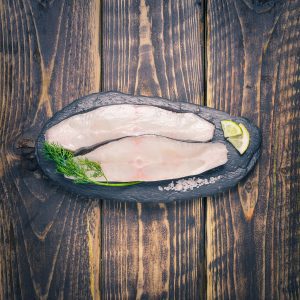
HOW DO YOU COOK HALIBUT?
The firm, creamy and meaty flesh of halibut lends itself perfectly to frying, grilling, roasting or poaching. Look for recipes that show you how to cook the fish quickly to ensure it doesn’t dry out, as halibut has a low oil content.
Thicker and firmer than cod, halibut has a gentle flavour that sits well with seasonings such as pesto, lemon juice and basil.
Though halibut is highly regarded by chefs, the best recipes keep things simple. The classic way to cook a fillet is gently pan-fried in butter and served on a bed of greens – beans, broccoli or spinach – with a simple butter lemon sauce. Cook the halibut skin-side down until it’s crisp and briefly on the other side.
Halibut sits very comfortably at the top of the food chain, and feeds by hunting other fish near the seabed
According to Hugh Fearnley-Whittingstall and Nick Fisher in The River Cottage Fish Book (A&C Black, 2007), halibut was once regarded as a cheap buy and referred to as “workhouse turbot”. Its reputation was transformed in the post-war years and it quickly became a regular on the menu at smart fish restaurants with a soaring price-tag:
“Halibut caught on as a restaurant-menu kind of fish that was chef-friendly – it made a lovely square fillet portion in the centre of a big round plate, and took a sauce well. The consensus among chefs was that halibut was no longer a fish to be denigrated but one to serve up with buttered spinach and hollandaise sauce.”
The price of halibut these days reflects its position as a much sought-after fish for fillet and steak recipes.
The best way to poach halibut fillet is in fish stock or white wine, then serve it with accompaniments that will complement rather than overpower this delicately flavoured fish.
A more recent delicacy is smoked halibut, the perfect ingredient for a serious gourmet dish at home
Delia Smith’s Complete Cookery Course (BBC Books, 1989) offers a fillet recipe that suggests baking halibut and serving with soured cream and capers.
“Place the pieces of fish in a well-buttered baking dish just large enough to accommodate them. Then add dry white wine or dry cider and dot with butter. Season with salt and pepper, sprinkle in tarragon, then cover the dish with foil and bake near the top of the oven for 20 minutes.”
Smith suggests a sauce made with butter, leek, the liquid from the baking dish, cream, capers and chopped watercress.
For alternative dishes, try roasting or grilling halibut steak. Cooking steaks is a quick and easy way to enjoy the large, tender flakes of flesh.
A more recent delicacy is smoked halibut, the perfect ingredient for a serious gourmet dish at home.
HALIBUT RECIPES
There’s no shortage of recipes that show how to cook halibut to perfection.
A good fillet recipe is ideal for a light lunch or a supper and the best way to cook the fish is with wine or stock to retain moisture.
When it comes to how to cook steak, remember this piece of fish is thicker cut and requires a different cooking technique from a fillet. Pay close attention to recommended cooking times and keep an eye on the texture of the flesh and you can’t go wrong.
Keep it simple and serve with parsley and cream sauce, a traditional accompaniment when cooking halibut. Or if you feel more adventurous, try gourmet trimmings such as asparagus, olives, capers or aioli.
Looking for inspiration? Search for these recipes online:
- Spiced halibut
- Crunchy halibut with creamy mash and sesame roasted kale
- Pan-fried seared halibut
- Baked halibut steak
- Halibut ceviche
- Seafood en croute
- Thai-syle halibut with coconut curry
- Halibut tacos
- Almond crusted halibut
- Filo-wrapped halibut fillets with lemon sauce
CLICK HERE TO BUY HALIBUT FILLETS
CLICK HERE TO BUY HALIBUT STEAK



